We’ve got the Best Flowering Oxalis Varieties, from the striking False Shamrock to the vibrant Iron Cross. Don’t miss out!
Oxalis plants are popular ornamentals, perfect for both indoor and outdoor settings. They have beautiful triangular leaves and adorable flowers, which vary in size from small to large, so there’s something to appease everyone. Don’t worry; here are the most beautiful flower oxalis varieties so you don’t get confused.
Best Flowering Oxalis Varieties
1. False Shamrock

Botanical Name: Oxalis triangularis
USDA Zones: 8-11
This is the most popular oxalis variety for growing anywhere indoors or outdoors. It hails from South America and has trifoliate leaves of violet shades with purple centers and tiny pink flowers, making this plant unlike any you’ve ever seen.
On top of that, it grows beautifully in loamy soil with little care. What more could you want? You can grow these indoors easily; just choose an east-facing window or a south-facing one with a curtain.
2. Iron Cross
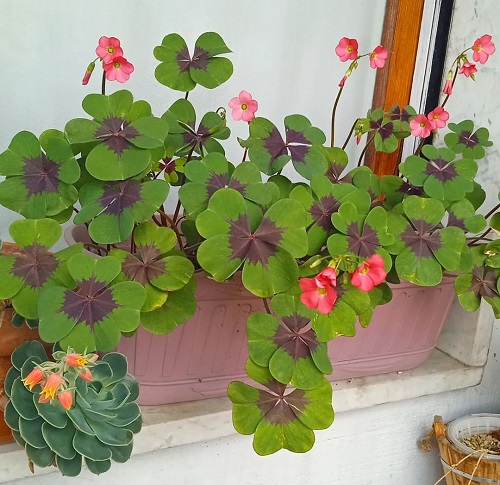
Botanical Name: Oxalis deppei
USDA Zones: 3-10
Iron cross oxalis has an adorable appearance, with its distinctive dark purple marks at the base of the four leaves, which make it look like a cross—earning it the name. It grows about a foot tall, and that, too, pretty quickly, so it’s a lovely flowering groundcover that can spread fast.
It also looks good in containers; all you have to do is place it in bright corners, and it’ll keep thriving and reward you with wonderful pink flowers.
3. Corymbosa

Botanical Name: Oxalis debilis ‘Aureo-Reticulata’
USDA Zones: 7-10
Corymbosa is also called the pink woodsorrel and is a beautiful flowering oxalis variety with three triangular leaflets. These are vibrant green in color and have veins highlighted in yellow or golden shades. It features pink or lavender flowers and thrives as a ground cover or in containers.
You can put it in direct light near a window indoors, but if it’s outside, make sure you give it bright, indirect light. Early morning sun is good for it, but not all day long.
4. Common Wood Sorrel
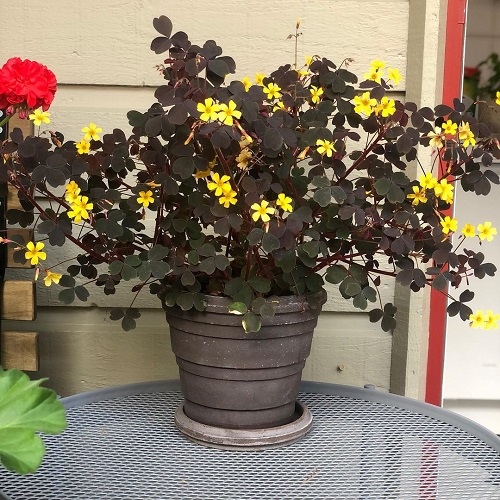
Botanical Name: Oxalis stricta
USDA Zones: 4-11
Common wood sorrels are native to North America and are mostly considered weeds; however, they can be a great lawn replacement. Plus, you won’t find many plants with the pastel green shade that its leaves display.
It also rewards a grower with tiny yellow flowers with five petals that bring a soft beauty to any spot.
Water it once every 1-2 weeks to keep the soil moist, and it will continue to thrive with pretty flowers.
5. Silver Shamrock
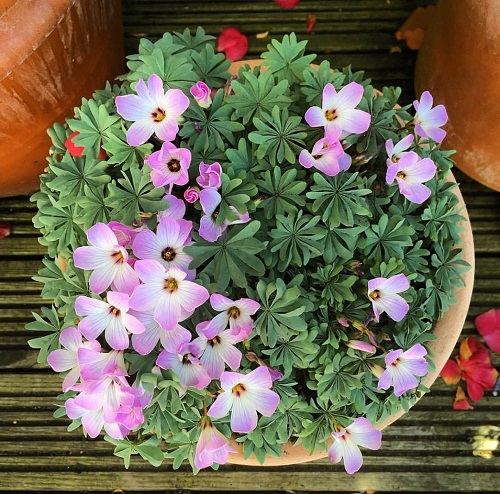
Botanical Name: Oxalis adenophylla
USDA Zones: 4-9
Silver shamrock should be at the top of your list if you want flowering oxalis varieties. It has dense clumps of delicate, slim, green leaves and beautiful flowers of pink and silver-white petals.
If you want the most out of this one, give it humus-rich soil and place it in full sun but harsh afternoons if growing in a warm climate. A bit of light shade every once in a while is also nice for it.
6. Scurvy Grass
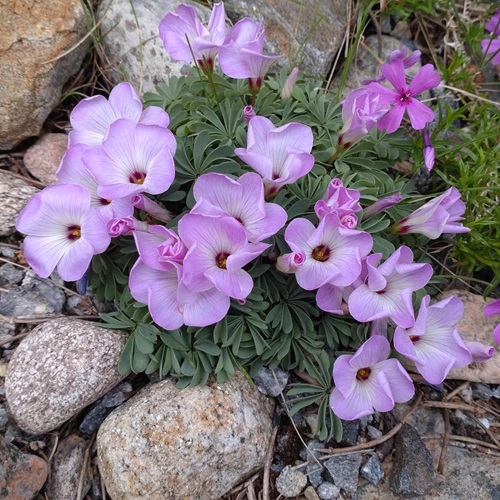
Botanical Name: Oxalis enneaphylla
USDA Zones: 5-9
The scurvy grass oxalis doesn’t have long stems or foliage. Instead, it has a mat-forming nature, which makes it perfect for ground cover. It likes moist soil but not running water, so it’s also perfect for container gardening.
Don’t believe it won’t give you flowers—it will give you plenty in a soft pink shade with purple veins and yellow centers. It enjoys direct sunlight for long hours, so you need not worry about sun damage!
7. Striped-flower Wood Sorrel

Botanical Name: Oxalis versicolor
USDA Zones: 8-10
Doesn’t it look like candy to you? The striped-flower wood sorrel has the most amazing flowers you’ll want to take a picture of. They are white and covered in red, wavy stripes, just like a candy cane.
It also stands out because of its thin and pointed leaves. This one can grow in various soils but will do best in a loamy growing medium.
8. Creeping Woodsorrel
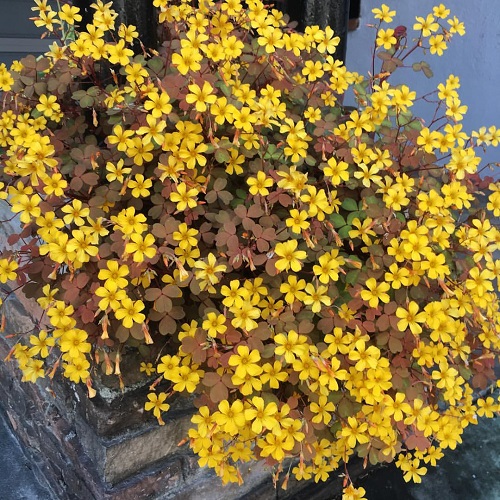
Botanical Name: Oxalis corniculata
USDA Zones: 4-8
This is a small oxalis with green or purple leaves depending on the period and intensity of light and weather. It blooms annually in the spring with tiny, bright yellow flowers.
Due to the structure and pattern, the leaves appear like petals, but when the yellow flowers come to life, they can please any plant lover.
Creeping woodsorrel needs full sun and usually needs watering once a week. Plant it in spring or fall for the best blooms.
9. Mountain Woodsorrel
Botanical Name: Oxalis montana
USDA Zones: 7-10
The mountain woodsorrel is a small, evergreen shrub native to South Africa. It grows about 3-6 inches tall and has small, leathery leaves. The flowers are a beautiful white color, covered in pink stripes, and have green centers.
These bell-shaped flowers produce tiny black seeds, making returning for the next season easy. Make sure the soil you choose to grow it in is loose and porous.
10. Alleluia
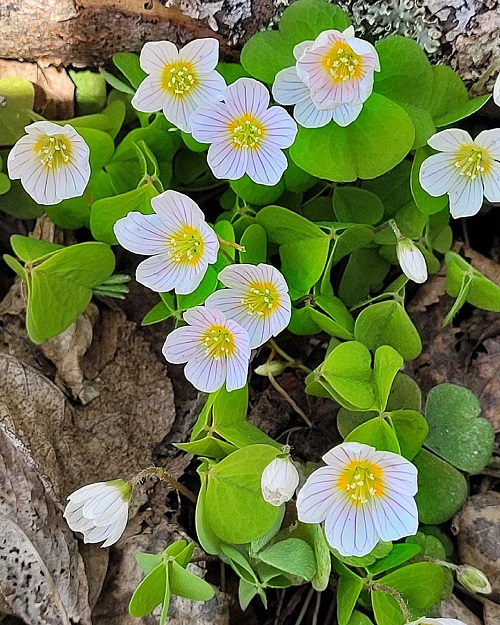
Botanical Name: Oxalis acetosella
USDA Zones: 3-7
Alleluia oxalis is also a common wood sorrel native to the UK. Its mat-forming nature makes it good for ground covers or rock gardens, but you should grow it in pots because of its lovely white flowers with yellow centers and black veins.
If you have pets or children, make sure they stay away from the pot because if consumed in a large quantity, it can be toxic to them.
11. Pink Sorrel
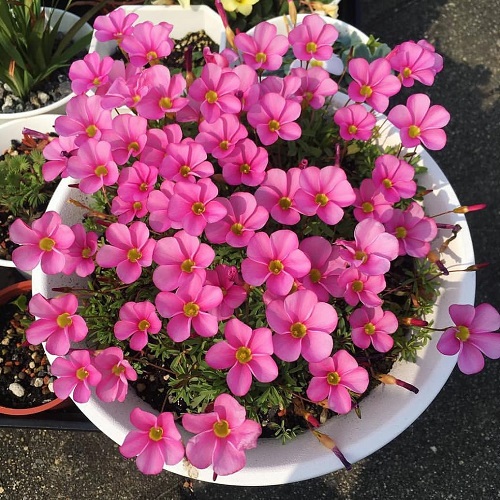
Botanical Name: Oxalis articulata
USDA Zones: 7-9
Pink sorrels are deciduous, clump-forming plants with tiny leaves and bright pink, gorgeous-looking flowers blooming throughout the late spring and summer. These flowering oxalis can brighten any indoor spot but need a lot of light, so keep them near a south-facing window.
Once established, they’re pretty easy to care for and only need occasional watering and a bit of fertilizer once a month during the growing season.
12. Purple Woodsorrel
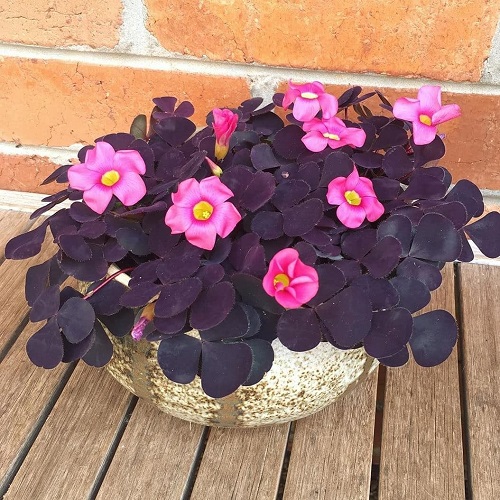
Botanical Name: Oxalis purpurea
USDA Zones: 9-10
Native to Southern Africa, the purple wood sorrels are currently grown as garden plants or houseplants in many places. They’re known for their dark purple or violet leaves and beautiful pink flowers with yellow centers.
They’re pretty easy to grow oxalis flowering varieties as long as you give them 4-6 hours of bright but indirect light. Plus, they don’t absorb water via the leaves, so stick to soil watering and don’t wet their foliage.


